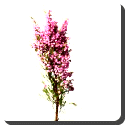 Heather — Calluna vulgaris is the sole species in the genus Calluna in the family Ericaceae. It is the true Heather of Europe, and National Flower of Norway. However it also has an affiliation to Scotland. It is a small perennial shrub growing to 20-50 cm tall (rarely to 1 m), and is found widely in Europe and Asia Minor on well-drained acidic soils in open sunny situations and in moderate shade. It is tolerant of moderate grazing and can regenerate following occasional burning. It is often managed in nature reserves using a light burning method. It is a common, often dominating, component of heath and moorland habitats, and also on peat bogs and in open pine forests.
Heather — Calluna vulgaris is the sole species in the genus Calluna in the family Ericaceae. It is the true Heather of Europe, and National Flower of Norway. However it also has an affiliation to Scotland. It is a small perennial shrub growing to 20-50 cm tall (rarely to 1 m), and is found widely in Europe and Asia Minor on well-drained acidic soils in open sunny situations and in moderate shade. It is tolerant of moderate grazing and can regenerate following occasional burning. It is often managed in nature reserves using a light burning method. It is a common, often dominating, component of heath and moorland habitats, and also on peat bogs and in open pine forests.
It is separated from the closely related genus Erica by its four-parted corolla and calyx. The flowers emerge in late summer, and in the wild species these are usually in purple or mauve shades.
Heather is an important food source for various sheep and deer which can graze the tips of the plants when snow covers low growing vegetation. Red Grouse feed on young shoots and seeds. Both adult and larva of the Heather Beetle Lochmaea suturalis feed on it, and can cause extensive mortality in some instances. The larvae of a number of Lepidoptera species also feed on the plant – see list of Lepidoptera which feed on Heather.
Heather is a popular ornamental plant in gardens and for landscaping. There are many named cultivars selected for variation in flower color, and for different foliage color and growing habits.
Different cultivars have flower colors ranging from white, through pink and a wide range of purples, and including reds. The flowering season with different cultivars extends from late July to November in the northern hemisphere. The flowers may turn brown but still remain on the plants over winter, and this can lead to interesting effects.
Cultivars with ornamental foliage are usually selected for reddish and golden leaf color. A few forms can be silvery grey. Many of the ornamental foliage forms change color with the onset of winter weather, usually increasing in intensity of colour. Some forms are grown for distinctive young spring foliage.
 Kids Portal For Parents India Kids Network
Kids Portal For Parents India Kids Network






